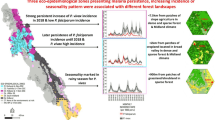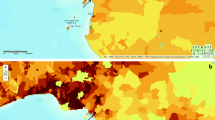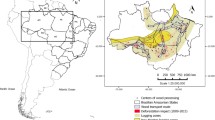Abstract
Approximately 3.9 billion people are at risk of infection with dengue fever, a group of viruses transmitted by mosquitoes (Halstead in Annu Rev Entomol 53:273–291, 2008. https://doi.org/10.1146/annurev.ento.53.103106.0933262008; WHO in WHO | Dengue and severe dengue, Geneva, 2018). In 2019, Central America suffered a severe dengue epidemic (Salinas Maldonado in Un brote de dengue pone en alerta a Centroamérica | Sociedad | EL PAÍS, El País, 2019). Costa Rica witnessed an almost doubling of the number of dengue cases in the first 24 epidemiological weeks of 2019 compared to the same period in the previous year (Ávalos in Costa Rica casi duplica número de enfermos de dengue en lo que va del año, con respecto al 2018, La Nación, 2019). In the Americas, forest cover is thought to diminish anthropogenic habitats for mosquitoes while also increasing the presence of their predators (Vasilakis et al. in Nat Rev Microbiol 9:532–541, 2011. https://doi.org/10.1038/nrmicro2595; Weterings et al. in Basic Appl Ecol 15:486–495, 2014a. https://doi.org/10.1016/J.BAAE.2014.07.006). In this study, we estimate the marginal effects of increasing forest cover on dengue prevalence in Costa Rica using econometric models to relate hospital admission records to forest cover maps from 2001 and 2011. We find that increasing the percentage of forest cover significantly decreases both the number of hospital admissions for dengue and the probability of an outbreak. Using the same models, we predict that if forest cover had been increased by three percentage points during 10 years (0.29% per year), 29 dengue hospital admissions per year might have been avoided (around 1.4% of cases in the country, depending on the year). This represents average savings between USD 7230 and 82,207 per year, depending on the severity of the impact on individuals with dengue. Our study demonstrates that forest conservation can serve as a public health investment, enhancing social welfare by mitigating illness and reducing associated healthcare expenditures. Our results must be interpreted with caution, however, as the characteristics of our data prevent us from confirming that the estimated negative effect of forest cover on dengue represents a causal impact.


Similar content being viewed by others
References
Agresta, DIMAP, Universidad de Costa Rica, Universidad Politécnica de Madrid (2015) Generating a consistent historical time series of activity data from land use change for the development of Costa Rica’s REDD Plus Reference Level. San José, Costa Rica
Ali S, Gugliemini O, Harber S et al (2017) Environmental and social change drive the explosive emergence of zika virus in the Americas. PLoS Negl Trop Dis 11:e0005135. https://doi.org/10.1371/journal.pntd.0005135
Ávalos Á (2019) Costa Rica casi duplica número de enfermos de dengue en lo que va del año, con respecto al 2018. La Nación
Bauch SC, Birkenbach AM, Pattanayak SK, Sills EO (2015) Public health impacts of ecosystem change in the Brazilian Amazon. Proc Natl Acad Sci 112:7414–7419. https://doi.org/10.1073/pnas.1406495111
Beck-Johnson LM, Nelson WA, Paaijmans KP et al (2013) The effect of temperature on anopheles mosquito population dynamics and the potential for malaria transmission. PLoS ONE 8:e79276. https://doi.org/10.1371/journal.pone.0079276
Berazneva J, Byker TS (2017) Does forest loss increase human disease? Evidence from Nigeria. Am Econ Rev Pap Proc 107:516–521
Burkett-Cadena ND, Vittor AY (2018) Deforestation and vector-borne disease: forest conversion favors important mosquito vectors of human pathogens. Basic Appl Ecol 26:101–110. https://doi.org/10.1016/j.baae.2017.09.012
Calderón-Arguedas Ó, Moreira-Soto R, Vicente-Santos A et al (2019) Papel potencial de Aedes albopictus Skuse en la transmisión de virus dengue (DENV) en una zona de actividad piñera de Costa Rica. Rev Bioméd. https://doi.org/10.1371/journal.pone.0157120
Camacho K, Avila ML (2016) Una Visión Comprensiva del Dengue en Centroamérica y República Dominicana: Epidemiología y recomendaciones vacunales Informe final
CCSS (2020) UNECLAC-CELADE::Redatam Webserver | Statistical Process and Dissemination Tool. https://redatam.ccss.sa.cr/bincri/RpWebEngine.exe/Portal? Accessed 16 Dec 2020
Chaves LSM, Conn JE, López RVM, Sallum MAM (2018) Abundance of impacted forest patches less than 5 km2 is a key driver of the incidence of malaria in Amazonian Brazil. Sci Rep 8:7077. https://doi.org/10.1038/s41598-018-25344-5
Chiu CH, Wen TH, Chien LC, Yu HL (2014) A probabilistic spatial dengue fever risk assessment by a threshold-based-quantile regression method. PLoS ONE 9:1–14. https://doi.org/10.1371/journal.pone.0106334
de Chaisemartin C, D’Haultfœuille X (2022) Two-way fixed effects and differences-in-differences with heterogeneous treatment effects: a survey. Economet J. https://doi.org/10.1093/ectj/utac017
FAO (2021) Global forest resource assessment 2020. FAO, Rome
FONAFIFO (2015) Estrategia Nacional REDD+ Costa Rica: Una iniciativa del Programa de Bosques y Desarrollo Rural. San José, Costa Rica
Funk C, Peterson P, Landsfeld M et al (2015) The climate hazards infrared precipitation with stations—a new environmental record for monitoring extremes. Scic Data 2:150066. https://doi.org/10.1038/sdata.2015.66
Garg T (2019) Ecosystems and human health: The local benefits of forest cover in Indonesia. J Environ Econ Manag 98:102271. https://doi.org/10.1016/j.jeem.2019.102271
Garg T, Hamilton SE, Hochard JP et al (2018) (Not so) gently down the stream: River pollution and health in Indonesia. J Environ Econ Manag 92:35–53. https://doi.org/10.1016/j.jeem.2018.08.011
Gersovitz M, Hammer JS (2003) Infectious diseases, public policy, and the marriage of economics and epidemiology. World Bank Res Obs 18:129–157
Graff Zivin JG, Neidell M (2013) Environment, health, and human capital. J Econ Lit 51:689–730
Halstead SB (2008) Dengue virus–mosquito interactions. Annu Rev Entomol 53:273–291. https://doi.org/10.1146/annurev.ento.53.103106.093326
Hassan RM, Scholes RJ, Ash Neville, Millennium Ecosystem Assessment (Program). Condition and Trends Working Group (2005) Ecosystems and human well-being : current state and trends: findings of the Condition and Trends Working Group of the Millennium Ecosystem Assessment. Island Press
INEC (2011) X Censo Nacional de Población y VI de Vivienda: Resultados Generales. San José
IUCN (2015) IUCN Standard on the Protection of Natural Habitats. International Union for Conservation of Nature
Kaewwaen W, Bhumiratana A (2015) Landscape ecology and epidemiology of malaria associated with rubber plantations in Thailand: integrated approaches to malaria ecotoping. Interdiscip Perspect Infect Dis 2015:1–17. https://doi.org/10.1155/2015/909106
Keesing F, Holt RD, Ostfeld RS (2006) Effects of species diversity on disease risk. Ecol Lett 9:485–498. https://doi.org/10.1111/j.1461-0248.2006.00885.x
Keiser J, Singer BH, Utzinger J (2005) Reducing the burden of malaria in different eco-epidemiological settings with environmental management: a systematic review. Lancet Infect Dis 5:695–708. https://doi.org/10.1016/S1473-3099(05)70268-1
Laporta GZ, de Prado PIKL, Kraenkel RA et al (2013) Biodiversity can help prevent malaria outbreaks in tropical forests. PLoS Negl Trop Dis 7:e2139. https://doi.org/10.1371/journal.pntd.0002139
Lindsay SW, Birley M (2004) Rural development and malaria control in Sub-Saharan Africa. EcoHealth 1:129–137. https://doi.org/10.1007/s10393-004-0025-6
Ling CY, Gruebner O, Krämer A, Lakes T (2014) Spatio-temporal patterns of dengue in Malaysia: combining address and sub-district level. Geospat Health 9:131–140. https://doi.org/10.4081/gh.2014.11
Lourenço-De-Oliveira R, Castro MG, Braks MAH, Lounibos LP (2004) The invasion of urban forest by dengue vectors in Rio de Janeiro. J Vector Ecol 29:94–100
MacDonald AJ, Mordecai EA (2019) Amazon deforestation drives malaria transmission, and malaria burden reduces forest clearing. Proc Natl Acad Sci 116:22212–22218. https://doi.org/10.1073/pnas.1905315116
Mace GM (2014) Whose conservation? Science 345:1558–1560. https://doi.org/10.1126/science.1254704
MEA (2005) Ecosystems and human well-being. Reference Module in earth systems and environmental sciences. https://doi.org/10.1016/B978-0-12-409548-9.09206-X
Ministerio de Salud (2018) Informe Anual 2017. San José
Mordecai EA, Paaijmans KP, Johnson LR et al (2013) Optimal temperature for malaria transmission is dramatically lower than previously predicted. Ecol Lett 16:22–30. https://doi.org/10.1111/ele.12015
Myers SS, Gaffikin L, Golden CD et al (2013) Human health impacts of ecosystem alteration. Proc Natl Acad Sci USA 110:18753–18760. https://doi.org/10.1073/pnas.1218656110
Nakhapakorn K, Tripathi N (2005) An information value based analysis of physical and climatic factors affecting dengue fever and dengue haemorrhagic fever incidence. Int J Health Geogr 4:13. https://doi.org/10.1186/1476-072X-4-13
OhAinle M, Balmaseda A, Macalalad AR et al (2011) Dynamics of dengue disease severity determined by the interplay between viral genetics and serotype-specific immunity. Sci Transl Med 3:114ra128. https://doi.org/10.1126/scitranslmed.3003084
Over M, Bakote’e B, Velayudhan R, et al (2004) Impregnated nets or DDT residual spraying? Field effectiveness of malaria prevention techniques in Solomon Islands, 1993–1999
Pattanayak SK, Pfaff A (2009) Behavior, environment, and health in developing countries: evaluation and valuation. Ann Rev Resour Econ 1:183–217. https://doi.org/10.1146/annurev.resource.050708.144053
Patz JA, Daszak P, Tabor GM et al (2004) Unhealthy landscapes: policy recommendations on land use change and infectious disease emergence. Environ Health Perspect. https://doi.org/10.1289/ehp.6877
Piaggio M, Siikamäki J (2021) The value of forest water purification ecosystem services in Costa Rica. Sci Total Environ. https://doi.org/10.1016/j.scitotenv.2021.147952
Polasky S, Segerson K (2009) Integrating ecology and economics in the study of ecosystem services : some lessons learned. Ann Rev Resour Econ 1:409–434. https://doi.org/10.1146/annurev.resource.050708.144110
Pongsiri MJ, Roman J, Ezenwa VO et al (2009) Biodiversity loss affects global disease ecology. Bioscience 59:945–954. https://doi.org/10.1525/bio.2009.59.11.6
Rodríguez I (2013) Costa Rica ha gastado más de ¢5.000 millones en atender el dengue - La Nación. In: La Nación. https://www.nacion.com/el-pais/costa-rica-ha-gastado-mas-de-c-5-000-millones-en-atender-el-dengue/J7K4JU32KBGKFDOALZFZFAPDVQ/story/. Accessed 27 Feb 2018
Roth J, Sant’Anna PHC, Bilinski A, Poe J (2023) What’s trending in difference-in-differences? A synthesis of the recent econometrics literatura. J Econom 235(2):2218–2244
Salinas Maldonado C (2019) Un brote de dengue pone en alerta a Centroamérica | Sociedad | EL PAÍS. El País
Sánchez-Azofeifa A (2015) Análisis de la cobertura forestal de Costa Rica entre 1960 y 2013. Ambientico 253:4–11
Santos AS, Almeida AN (2018) The impact of deforestation on Malaria infections in the Brazilian Amazon. Ecol Econ 154:247–256. https://doi.org/10.1016/J.ECOLECON.2018.08.005
Sarfraz MS, Tripathi NK, Tipdecho T et al (2012) Analyzing the spatio-temporal relationship between dengue vector larval density and land-use using factor analysis and spatial ring mapping. BMC Public Health 12:1–19. https://doi.org/10.1186/1471-2458-12-853
Sierra R, Cambronero A, Vega E (2016) Patrones y factores de cambio de la cobertura forestal natural de Costa Rica, 1987–2013. San José
Sithiprasasna R, Linthicum KJ, Lerdthusnee K et al (1997) Use of geographical information system to study the epidemiology of dengue haemorrhagic fever in Thailand. Dengue Bull 21:68–72
Springborn MR, Weill JA, Lips KR et al (2022) Amphibian collapses increased malaria incidence in Central America *. Environ Res Lett 17:104012. https://doi.org/10.1088/1748-9326/AC8E1D
Tan-Soo J-S, Adnan N, Ahmad I et al (2016) Econometric evidence on forest ecosystem services: deforestation and flooding in Malaysia. Environ Resour Econ 63:25–44. https://doi.org/10.1007/s10640-014-9834-4
United Nations (2015) Transforming our World: the 2030 Agenda for Sustainable Development Transforming our world: the 2030 Agenda for Sustainable Development Preamble
Vanwambeke SO, van Bethem BHB, Khantikul N et al (2006) Multi-level analyses of spatial and temporal determinants for dengue infection. Int J Health Geogr 5:1–16. https://doi.org/10.1186/1476-072X-5-5
Vasilakis N, Cardosa J, Hanley KA et al (2011) Fever from the forest: prospects for the continued emergence of sylvatic dengue virus and its impact on public health. Nat Rev Microbiol 9:532–541. https://doi.org/10.1038/nrmicro2595
Vette K, Bareja C, Clark R, Lal A (2018) Establishing thresholds and parameters for pandemic influenza severity assessment, Australia. Bull World Health Organ 96(8):558–567. https://doi.org/10.2471/BLT.18.211508
Vincent JR, Ahmad I, Adnan N et al (2015) Valuing water purification by forests: an analysis of Malaysian panel data. Environ Resour Econ. https://doi.org/10.1007/s10640-015-9934-9
Vincent JR, Ahmad I, Adnan N et al (2016) Valuing water purification by forests: an analysis of Malaysian panel data. Environ Resour Econ 64:59–80. https://doi.org/10.1007/s10640-015-9934-9
Weterings R, Umponstira C, Buckley HL (2014a) Container-breeding mosquitoes and predator community dynamics along an urban-forest gradient: the effects of habitat type and isolation. Basic Appl Ecol 15:486–495. https://doi.org/10.1016/J.BAAE.2014.07.006
Whitmee S, Haines A, Beyrer C et al (2015) Safeguarding human health in the Anthropocene epoch: report of the Rockefeller Foundation–Lancet Commission on planetary health. The Lancet 386:1973–2028. https://doi.org/10.1016/S0140-6736(15)60901-1
WHO (2009) Dengue: guidelines for diagnosis, treatment, prevention and control. WHO, Geneva
WHO (2018) WHO | Dengue and severe dengue. World Health Organization, Geneva
Willmott CJ, Matsuura K (2015) Terrestrial air temperature: gridded monthly time series (1950–2014) (V 4.01). http://climate.geog.udel.edu/~climate/html_pages/Global2014/README.GlobalTsT2014.html
Wood CL, McInturff A, Young HS et al (2017) Human infectious disease burdens decrease with urbanization but not with biodiversity. Philos Trans R Soc B Biol Sci 372:20160122. https://doi.org/10.1098/rstb.2016.0122
Wooldridge JM (2010) Econometric analysis of cross section and panel data, vol 58. MIT Press, Cambridge, p 1096
Xirinachs Y (2016) Cost-effectiveness analysis of a dengue vaccine in Costa Rica. In: ISPOR 19th annual congress—29 Oct–2 Nov 2016, Vienna, Austria. Vienna, p 2016
Yasuoka J, Levins R (2007) Impact of deforestation and agricultural development on anopheline ecology and malaria epidemiology. Am J Trop Med Hyg 76:450–460
Acknowledgements
This paper was funded by the Latin American Environmental Economics Program. We are grateful for comments and suggestions from the participants in the workshop “Ecosystems, human behavior, and health,” organized by EfD-CATIE, the University of Vermont and Stanford University, as well two anonymous reviewers and Julie Bleha for their helpful comments. Allan Coto processed weather variables. Matías Piaggio was affiliated to the International Union for Conservation of Nature when the majority of the work was done. He is currently employed as a Senior Economist by an international financial institution.
Author information
Authors and Affiliations
Corresponding author
Ethics declarations
Conflict of interest
Disclosure of potential conflicts of interest: The authors declare that they do not have any conflict of interest to disclose.
Research Involving Human Participants and/or Animals
Non-applicable.
Informed Consent
Non-applicable.
Additional information
Publisher's Note
Springer Nature remains neutral with regard to jurisdictional claims in published maps and institutional affiliations.
Supplementary Information
Below is the link to the electronic supplementary material.
Rights and permissions
Springer Nature or its licensor (e.g. a society or other partner) holds exclusive rights to this article under a publishing agreement with the author(s) or other rightsholder(s); author self-archiving of the accepted manuscript version of this article is solely governed by the terms of such publishing agreement and applicable law.
About this article
Cite this article
Piaggio, M., Guzman, M., Pacay, E. et al. Forest Cover and Dengue in Costa Rica: Panel Data Analysis of the Effects of Forest Cover Change on Hospital Admissions and Outbreaks. Environ Resource Econ (2024). https://doi.org/10.1007/s10640-024-00853-2
Accepted:
Published:
DOI: https://doi.org/10.1007/s10640-024-00853-2




